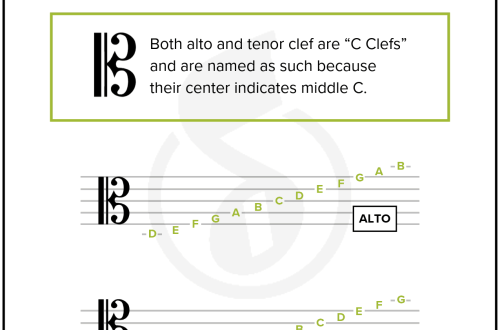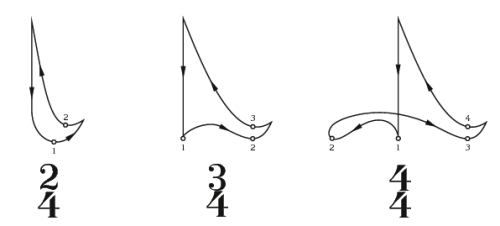
How to conduct different time signatures?
Contents
In this article, we will discuss the basics of conducting. Of course, conducting is a whole art that has been taught for many years in music colleges and conservatories. But we will touch on this topic only from one edge. All musicians have to conduct while singing in solfeggio lessons, so we’ll talk about how to do it.
Basic conductor circuits
There are universal conducting schemes for simple and complex time signatures. There are only three of them – two-part, three-part and four-part. When conducting, each beat is shown with a separate wave of the hand, strong beats are most often shown with a downward gesture.
In the figure you can see the main three schemes for conducting with the right hand. Numeric marks indicate a sequence of gestures.
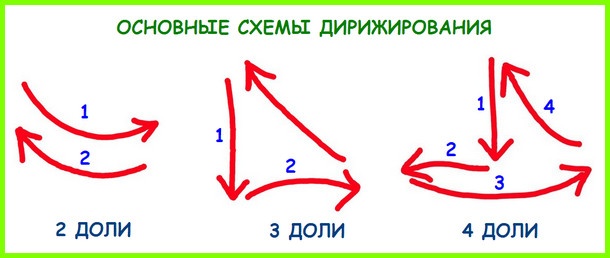
Bipartite scheme consists, respectively, of two strokes: one down (to the side), the second up (back). This scheme is suitable for conducting in sizes 2/4, 2/8, 2/2, 2/1, 2/16, etc.
Tripartite scheme is a combination of three gestures: down, to the right (if you conduct with your left hand, then to the left) and up to the original point. The scheme is suitable for sizes 3/4, 3/8, 3/2, 3/16, etc.
Quadruple scheme contains four gestures: down, left, right and up. If you conduct with two hands at the same time, then on “two”, that is, on the second share, the right and left hands move towards each other, and on “three” they diverge in different directions, on the last stroke they converge up to one point.
Conducting more complex meters
If there are more beats in a bar, then such time signatures fit into a three-beat or four-beat scheme with doubling of some gestures. Moreover, as a rule, those strokes that are closer to the strong share are doubled. As an example, I would like to give schemes of such sizes as 6/8, 5/4 and 9/8. Let’s say a few words about each.
Size 6/8 – complex (composition 3/8 + 3/8), to conduct it you need six gestures. These six gestures fit into a quadruple pattern, where the movements down and to the right are doubled.
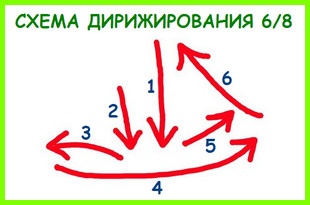 What is the logic of doubling? It consists of the following. The original 4/4 scheme is, as it were, divided into two halves: the first two gestures (down and left) are for the first 3/8, and the next two gestures (right and up), respectively, fall on the second half of the bar, the second 3/8. As a general rule, you need to double the strong and relatively strong beats, which just fall on the beginning of these two halves of the four-beat scheme.
What is the logic of doubling? It consists of the following. The original 4/4 scheme is, as it were, divided into two halves: the first two gestures (down and left) are for the first 3/8, and the next two gestures (right and up), respectively, fall on the second half of the bar, the second 3/8. As a general rule, you need to double the strong and relatively strong beats, which just fall on the beginning of these two halves of the four-beat scheme.
Thus, in 6/8 time, “one and two” are gestured down, “three” is conducted to the left (if with the right hand), “four and five” is a relatively strong beat with its doubling, they are shown to the right, and “six” completes the scheme with a gesture up.
Size 5/4 exists, as already noted, in two versions, and therefore, there are two different schemes for conducting this meter. Both of them fit into the main four-part scheme and differ only in the doubling of one of the gestures. If 5/4 u3d 4/2 + 4/5, then the downward swing is doubled, the very first. If, on the contrary, 4/2 u4d 3/4 + XNUMX/XNUMX, then in this case you need to double the gesture to the right, which falls on a relatively strong share.
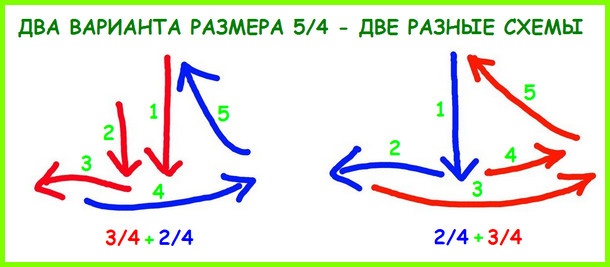
Size 9/8 also considered complex, it is formed by a triple repetition in a measure of a simple 3/8 time signature. Unlike other complex meters, it is conducted in a three-part pattern, where each stroke is simply tripled. And the changes of gestures (to the right and up) in this case simultaneously show relatively strong beats.
Memo on conducting schemes
In order for the conducted conducting schemes not to be forgotten over time, as well as for their quick repetition if necessary, we suggest you download or rewrite a small memo with the main schemes for yourself.
MANAGEMENT SCHEME – DOWNLOAD
How do hands work when conducting?
We will also tell you about some purely technical aspects of conducting.
MOMENT 1. You can conduct with one or two hands. Most often, in solfeggio lessons, I conduct with one right hand, sometimes with one left (they play a melody on the piano with the right at this time).
MOMENT 2. When conducting with both hands at the same time, the hands should move in a mirror image in relation to each other. That is, for example, if the right hand goes to the right, then the left hand goes to the left. In other words, they always move in the opposite direction: either they diverge in different directions, or, conversely, they converge and move towards each other.
MOMENT 3. In the process of conducting the whole arm from the shoulder should take part (sometimes even higher from the collarbone and shoulder blade) and to the fingertips. But a wide variety of movements is characteristic only of the activities of professional conductors of an orchestra or choir. In the solfeggio class, it is enough to clearly show the scheme, thereby helping yourself to sing rhythmically.

MOMENT 4. When conducting simple schemes, the forearm (ulna) turns out to be the most mobile, it is it that takes on most of the movements – it leads the entire arm down, to the sides or up. When moving to the side, the forearm actively helps the shoulder (humerus), it moves away from the body or approaches it.
MOMENT 5. When moving up, it is important that the forearm does not drop too low, a natural low point is when a right angle forms between the forearm and the shoulder.
MOMENT 6. During conducting, the hand can respond to the main movements and slightly smoothly spring, while changing the direction of the gesture, the hand with the help of the wrist can slightly turn in the direction of movement (as if it serves as a steering wheel).
MOMENT 7. Movements as a whole should not be rigid and straightforward, they need to be rounded, all turns should be smooth.

Conducting exercises in 2/4 and 3/4 time signatures
To practice elementary conducting skills, follow the suggested simple exercises. One of them will be devoted to the size 2/4, the other – to the tripartite pattern.
EXERCISE №1 “TWO QUARTERS”. For example, we will take 4 measures of a melody in 2/4 time. Pay attention to the rhythm, here it is quite simple – mostly quarter notes and a half duration at the end. Quarter durations are convenient in that they measure the pulse and it is this duration that each gesture in the conductor’s scheme is equal to.
There are two quarter notes in the first measure: DO and RE. DO is the first beat, strong, we will conduct it with a downward (or sideways) movement. Note PE is the second beat, weak, the hand during its conducting will make the opposite movement – up. In subsequent measures, the rhythmic pattern is similar, so there will be exactly the same relationships between notes and hand movements.
In the last, fourth measure, we see one note DO, it is half in its length, that is, it occupies both beats at once – the entire measure. Therefore, this DO note has two strokes at once, you need to conduct the full measure that it occupies.
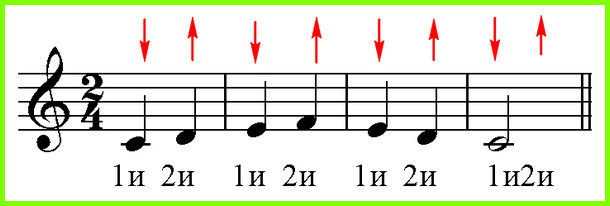
EXERCISE №2 “THREE QUARTERS”. This time, 4 measures of the melody in 3/4 time are offered for study. The rhythm is again dominated by quarter notes, and therefore three quarter notes in the first three measures should easily fall on three strokes of the scheme.
For example, in the first measure, the notes DO, PE and MI will be distributed according to the scheme as follows: DO – for a downward gesture, PE – for a movement to the right, and MI – for showing the last beat with an upward movement.
In the last measure – a half note with a dot. In terms of duration, they take up a whole measure, three quarters, and therefore, in order to conduct it, we will need to perform all three movements of the scheme.

How to explain conducting to a child?
In classes with kids, the most difficult thing is to introduce the scheme, remember the movements and at least practice them a little. The solution of these problems can be helped by working with figurative associations.
Suppose, if we are learning the 2/4 conducting scheme, then each swing needs to be somehow artistically determined. In other words, to explain the gesture, you need to find a similar movement or sensation from life that is already familiar to the child. For example, about the downward gesture with which we show a strong beat, we can say that it is as if we are stroking a sitting cat from head to tail. And about the gesture directed in the opposite direction, say that we are pulling up a needle with a long thread. Or, for example, about the entire scheme, we can say that it is our hand that rides on a swing (description of a semicircle).
If we are talking about the size of 3/4, then each movement can also be explained separately. The downward movement is like playing with a basketball or such a movement when we pull a bell on a string. Movement to the right – on the beach we rake sand with our hands or we remove tall grass on the lawn with our hands. Moving up – we pull the same needle and thread or launch a ladybug that sits on the index finger into flight.
In mastering conducting with children, as in learning musical notation, it is important to consistently increase the level of complexity of tasks. First, you can realize the pulsation in size purely musically – by ear and when playing the instrument, then separately work out the conductor’s gesture, and only then, finally, connect your hand with singing.
On this we will slow down for the time being. If this tutorial was useful to you, please tell your friends about it. The social network buttons, which are located just below on the page, will help you with this.



